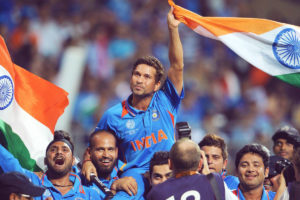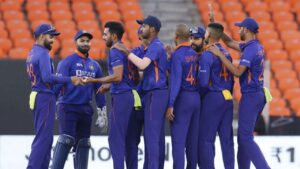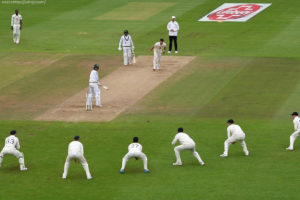The 80s marked a significant decade for Indian cricket, one that saw us make huge strides forward. With the World Cup victory in 1983 giving a major fillip to the sport in India, we enjoyed a golden phase from 1983 to ‘85 in which we followed up the famous victory at Lord’s with multiple tournament wins including the Benson & Hedges WCC in Australia. In test cricket we had lots of challenges throughout the decade though there were really high points like the 2-0 win in England in 1986. Two big names used to stand out in Indian cricket in the 80s- those of Sunil Gavaskar and Kapil Dev. In the second half of the decade, with Sunny’s retirement, Dilip Vengsarkar became the driving force of our batting unit while other key batsmen also came to the fore. India struggled to find match-winning bowlers to complement Kapil, accentuating our travails outside the sub-continent. One vital cog in the wheel in the 80s was Ravi Shastri who came in as a left-arm orthodox spinner, eventually evolving into a batsman who could play different roles depending on the need of the hour. He was neither a run machine like Sunny nor an all-rounder spoken of in the same breath as Kapil, but he was useful with the bat and the ball. His repertoire of strokes was limited, but he made up for it with guts and spirit.
His self-belief stood him in good stead and he was a great student of the game. Playing overseas against hostile pace bowers in their backyard was perhaps the biggest challenge for India in test cricket in the 80s.
The hosts would go all guns blazing, and courageous resistance and counter-attacks of those days from top order batsmen like Gavaskar and Jimmy Amarnath used to be celebrated in Indian media. Often missed out in such discourses even today are the fighting knocks played by Ravi Shastri under trying circumstances against the best fast bowlers in business, putting a huge price on his wicket and making him tougher to dislodge than other batsmen with wider range of strokes. Also, in a complete reversal of roles in home conditions, like a typical all-rounder, he would also push for runs with the team in an advantageous position. A useful spinner, he operated in tandem with bowlers like Maninder Singh, and was a key link in our bowling machinery in spin-friendly conditions. With 151 test wickets in 80 tests, he had more scalps than any other Indian spinner in the era that came after the famous quartet and before the advent of Anil Kumble, even though he wasn’t a big turner of the ball. He was right there in the thick of things in memorable cricketing occasions in the mid 80s. Ravi was seen as a captaincy candidate from a young age; however he ended up being the Vice-Capatin to many skippers who were top order batsmen, possibly because of dip in form at points in time when he could have landed the job. Still, whenever he was asked to stand in as Captain of Team India, he did an admirable job of it. He was versatile as a cricketer, and adapted himself to the needs of the team. A look at few key moments from his career chronology will elucidate the point further.

He made his test debut in 1981 as a last minute replacement for the injured Dilip Doshi when he flew into New Zealand the night before the first test. With 15 wickets in 3 tests, he was the leading wicket-taker on either side. Batting at No. 10 initially, he ended up batting in all positions from No.1 to No.10 in his career! His first century came just two years after his debut, in Pakistan against Imran Khan and Sarfraz Nawaz; he scored 128 runs while opening the batting with Sunny Gavaskar in the last test of the six-match series that we lost 3-0. His second ton came in the next series in the West Indies against an attack comprising of Marshall, Holding, Roberts and Davis. His 3830 test runs included eleven centuries of which seven were scored outside India, with two of them coming in West Indies against their famed paced battery.
The 1985 WCC held in Australia was a high point in Ravi’s career. It was a mini-World Cup and India won the title without losing a single match. Shastri played the sheet-anchor role as an opener in perfect contrast to the role played by Srikkanth, his swashbuckling opening partner. Ravi’s role was to hold the innings together allowing other stroke players to bat freely around him. While L Sivaramakrishnan was our lead spinner, Ravi also chipped in with vital strikes for the team. He was crowned the ‘Champion of Champions’ of the tournament, and the team celebration in the Audi Car that he won, is a memorable moment from the 80s. Shortly afterwards, he spun Bombay to victory in the Ranji Trophy finals with figures of 8/91 in the fourth innings after conceding a vital first innings lead to Delhi. It was also the year in which he hit six 6s in an over in a Ranji Match against Baroda, while scoring an unbeaten 200 which was the fastest double century then in first-class cricket- surprising achievement from someone remembered as a sedate batsman.

Over the next couple of years, we saw him as a more free-stroking batsman in home conditions, batting at No.6 and 7, often dancing down the track and hitting the spinners for glorious sixers. His role in the historic Tied Test against Australia in 1986, keeping the run chase on after the loss of the top order batsmen, and taking the game into the last over, is now part of cricketing history. A good reader of the game, he never really got to be the long-term Indian captain. After the days of Kapil and Sunny as captains, the job went to Vengsarkar, Srikkanth and Azharuddin. In Dilip’s absence in the Madras Test in 1987 against the Windies, Ravi captained the team when Narendra Hirwani spun us to a famous victory, enabling us to level the series 1-1. After that series, he also captained us to victory in a tri-nation event in Sharjah with wins over New Zealand and Sri Lanka.
In the latter part of his career, as he concentrated more on batting in the role of a test opener, he scored two big 100s on foreign soil – 187 at the Oval and 206 at the SCG. Both these innings were testimony to his determination and resolve to grind it out in the middle, something that many prolific stroke-makers struggled to do. In fact in the Sydney game, he almost took us to victory on the 5th day as the lone spinner in the XI, necessitating a typical Allan border rescue act to prevent an Indian win.
The 1992 World Cup in Australia and New Zealand was not a great one for Shastri. As an opener he got runs in the initial games but his scoring wasn’t fast enough. He seemed to have stretched the anchorman brief a bit too much and was dropped from the playing XI after the initial games. The ODI game was moving forward, with teams adopting more aggressive approaches at the beginning of the innings. The plan that worked for him in the WCC event in 1985 wasn’t good enough in 1992. After he was dropped from the XI, India continued to struggle in the tournament and our opening combination was never really able to set the stage on fire. While it could be argued in Ravi’s defence that it was his role to hold one end tight and that the targets we were chasing weren’t huge, the optics of a score of 57 runs in 112 balls against England and 25 of 67 balls against Australia were not great.
In both these cases we failed to chase down scores in the 230s.

Recurring knee issues were disturbing him and there were concerns around his fitness at the World Cup. He played the Test and ODI series in South Africa after that but he didn’t enjoy much success in the test series. Though he did show the heart to play the attritional game under tough circumstances, big scores eluded him. This tour was the last time he played for Team India. In the home series against England that followed, Anil Kumble announced himself in a big way, as we gained a winning momentum at home. It must be mentioned, still, that he played one cameo in the South African tour when he reminded us of his utility and versatility as a team player. In the third ODI, when he came in to bat with 44 runs needed to win in 38 balls, the commentator mentioned that he was certainly not the man for the situation, in the backdrop of the perceptions created because of the World Cup performance. Ravi shifted gears and scored a match-winning 27 not out from 16 balls with the ball going to the fence like a tracer bullet on multiple occasions against Donald and his bowling partners.
At Centurion Park on that day, Shastri finished it off in style, with India winning with 5 balls to spare. It was a rare victory in a tough tour and that kind of an innings then, from team India’s perspective, was just what the doctor ordered!





www.treadmillreviews.xyz
27 May 2021Thanks for sharing your info. I truly appreciate your efforts and I will be waiting for your further post thanks once again.